
|
Sale 70
The September 2-5, 2012
| Lot |
Photo |
Description |
Realized |
Lot 2248 |
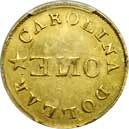 |
Christopher Bechtler, ONE DOLLAR CAROLINA, 28 Gr., N reversed. PCGS graded AU-55. Light golden toning with tints of green, a lustrous, and very attractive specimen of this historic Carolina gold piece. The Bechtler mint was a private enterprise conducted at the residence of Christopher Bechtler, and operated by him and the Bechtler family. The enterprise was highly esteemed in its time, well covered in newspapers and financial journals, and served great utility in providing circulating coins in that region. There were no mints in North Carolina or Georgia until 1838, and the Bechtler enterprise, which began in 1830, filled an important niche. The federal government did not pester the Bechtlers, but allowed the private mint to continue in full operation, although now and again mention of it was made in the Annual Report of the Director of the Mint. Pop 25; 17 finer (PCGS # 10055) .
Estimated Value $2,000 - 2,200.
View details and enlarged photos
Check results on similar lots
| Realized
$5,750 |
Lot 2249 |
 |
August Bechtler, 5 DOLLARS CAROLINA, 141 Gr. 20 Carats NGC graded AU Details. Tooled and cleaned. Not as bad as the description sounds on the NGC slab. A very pleasing looking example. The design of this piece is at once simple and serviceable. There are no special design elements, except perhaps for the star on the obverse. The lettering appears entered in the die with a utilitarian purpose, and with little regard for artistry. For example, the letters of CARATS below the 5 are misaligned with the other letters. The neighboring G appears to have tripped and fallen away from the GOL as if it did not want to be associated with the others. Many engraving irregularities could be pointed out on both sides, especially regarding improper spacing. And yet…the Bechtler gold coins served a function. Well into the 1860s these hard-working coins were found circulating throughout the region, indeed, far away from their mint of issue, and in competition with regular-issue U.S. gold coins!
Estimated Value $9,000 - 10,000.
View details and enlarged photos
| Unsold |
Lot 2250 |
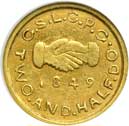 |
1849 Mormon $2.50 Gold. NGC graded AU-58. A hint of light gold tone. Once the Gold Rush in California began in earnest in 1849, enough gold dust had found its way into the Mormon treasury to begin private gold minting. On November 25th of 1849, Brigham Young, John Kay, and John Taylor formed a consortium to design the symbols used on these intriguing gold pieces. Brigham Young personally supervised the mint, which was housed in a little adobe building in Salt Lake City, Utah. The mint was inaugurated late in 1848 as a public convenience. $2.50 gold pieces were struck in 1849 exclusively (unlike the $5 denomination which was also struck in 1850 and 1860). Of course, the Mormon $2.50 is a rare item in all grades, with sufficiently few at the About Uncirculated 58 level to excite just about every collector of Territorial gold who contemplates owning a Mormon coin. The surfaces are warm gold in color with a hint of orange and are very choice, not at all atypical for the Type which tends to be found rather heavily abraded or suffering rim problems. It is no secret either, since the photos reveal all, that the two clasped hands are fully struck, including full separation of the thumb, which is another reason why territorial collectors will fall in love with it. A couple of wispy marks and hairlines are only detectable under a lens. Pop 4; 3 finer in 62 (PCGS # 10259) .
Historic note: The Mormons quickly involved themselves in the California Gold Rush which began in 1848. Many of the faith already resided along the American River where gold was first discovered. In no time, the new gold ore was carted to Salt Lake City, Utah to the Mormon Territory. The minting equipment to strike the coins was acquired and dies made. The devices include the Emblem of the Mormon Priesthood: a three-pointed Phrygian crown above the all-seeing eye. HOLINESS TO THE LORD surrounds. On the reverse, the clasped hands denote friendship, G.S.L.C.P.G. is abbreviated for Great Salt Lake City Pure Gold (never mind the gold having originated in California). Gold coins were in desperate need for commerce. Many circulated well beyond the boundaries of the Utah Territory, including into California's Gold Rush country.
Estimated Value $40,000 - 50,000.
The Stocker Estate.
View details and enlarged photos
Check results on similar lots
| Realized
$69,000 |
Lot 2251 |
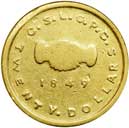 |
1849 Mormon $20 Gold. NGC graded AU-50. This is one of the rarest Pioneer gold coins and also one of the most important. The 1849 Mormon issues were the first Pioneer gold coins struck from California gold. And the 1849 $20 is the largest denomination of the Mormon gold coins. But this denomination, and the even rarer 1849 $10, were struck in extremely limited quantities.
David Hall, who examined the Smithsonian example (through a plexi-glass display case) said in an opinion piece, "I believe PCGS would grade the coin MS61. It is arguably the finest known. This coin came from the incredible Lilly collection, which was donated in whole to the Smithsonian. Most of the great Pioneer gold coins in the Smithsonian are from the Lilly collection."
The Stocker Estate specimen of the Mormon $20, the presently offered About Uncirculated 50, is the second finest in private hands (see below) and, crucially, available now! A fantastic opportunity to acquire this significant rarity, the first $20 piece circulated in the United States. Choice light yellow gold surfaces show uniform color throughout. Notably free of major marks and showing excellent natural surfaces, a fact that separates it from most lesser survivors, including the Judge Slack-James Stack specimen, the specimen sold by Bowers and Merena in August 1995, the Garrett coin, the bruised Eliasberg coin, the tooled Walton-Gibson piece, the burnished specimen in the September 1984 Bowers and Merena sale, and others seen. What marks are present are extremely minor: a small nick below the 4 of 1849, another equally small mark above C.[P.] along with a shallow indentation (possibly as made) above and to the right of the 9 in the date. Two distinguishing features on the reverse are marks between H & E in THE, a diagonal nick below H[OL], and a rim irregularity above TO at the 7 to 8 o�clock position.
Coined beginning on September 1849 from unrefined California gold dust brought overland, the Mormon $20 coins were the first of that denomination ever struck in the United States, preceding even the unique Federal 1849 $20 by three months and beating the circulation strike 1850 double eagles by an even longer margin. These $20 pieces have the distinction of being the first $20 gold pieces struck in the United States.
Mormon $20 coins were of natural alloyed gold and were easily abraded. In the middle of November that year, according to the definitive Dr. Donald Kagin reference work on Territorial Gold coins, "$600 worth of silver was purchased for hardening the coins. This may account for the weight variance in the same design coin or for the slightly heavier 1850 $5 issues."
Kagin goes on to describe how, "Although the Mormon coins probably were intended for local transactions only, and therefore taken at par by the Salt Lake City merchants, many of them were used to purchase goods from outsiders. As early as May 1850, Mormon coins appeared as far east as St. Louis, Missouri. By the end of the year the coinage began to appear in most sections of the country, especially at major port cities."
Few collectors outside of numismatic academia realize that the history of the California Gold Rush is part and parcel with that of the Church of Jesus Christ of Latter Day Saints, more familiarly known as the Mormon Church. As Don Taxay has pointed out, "Mormon �Forty-Niners� included both James Marshall (who made the actual discovery of gold, Jan. 24, 1848) and Sam Brannan (who galloped through San Francisco streets shouting about it), as well as many of the earliest miners. One of the richest deposits found was on Mormon Island, downstream from Sutter's Mill at Coloma on the American River."
Following up on this, Walter Breen in his encyclopedia explains, "When Mormon miners began bringing gold dust back in quantity to Deseret ('Honeybee') Territory (the Salt Lake City area), Brigham Young conceived the idea of creating a distinctive local coinage. On Nov. 25, 1848, Young and John Taylor conferred with John Mobourn Kay, formerly connected with one of the Birmingham (England) private mints, to determine procedures for smelting and coining California gold ores. Between them they determined the devices and inscriptions. Kay and Alfred B. Lambson forged the die blanks; Robert L. Campbell and Kay engraved them."
"The obverse of the $20 gold piece depicts the Emblem of Mormon Priesthood, the "three-pointed Phrygian Crown," above the All-Seeing Eye. HOLINESS TO THE LORD is the King James Version's rendering of Exodus 28:36, originally intended for engraving on the Hebrews' sacred jewels. The clasped hands device stands for friendship. G.S.L.C.P.G. = "Great Salt Lake City Pure Gold," though the bullion all came from California except for the 1860 mintage, which was from Colorado gold. On the $10, instead of the initials, was PURE GOLD. Both labels were misnomers: Not only was California gold naturally alloyed, the Salt Lake City coiners admixed it still further. The Latter Day Saints' own term for their gold pieces was �Valley Coins.�"
Breen further points out, "The very first issue was of $10 denomination. Kay struck [46] $10s in Dec. 1848: 25 on Dec. 12, 21 more on Dec. 19. Apparently the dies were dated 1849 in anticipation of coinage continuing into the next year. Immediately afterward, the crucibles broke, so that no more ore could be smelted, no ingots formed. As the need for a circulating medium was severe, Brigham Young (with others of the Mormon Church's 12 Apostles) signed and circulated handwritten paper currency dated between Dec. 29, 1848, and Jan. 5, 1849. These (along with several later issues of 1849) were recalled and burned after the Church managed to buy new crucibles, Sept. 1849.
"Coinage resumed on Sept. 12, at the Deseret Mint, actually the home of Dr. William Sharp, South Temple Ave., Salt Lake City, now the site of the Hotel Utah garage… Kay and Campbell made dies for $2-1/2, $5, and $20 coins. Any more $10s must have been from the old dies. They struck many thousands of specimens of $2-1/2s and $5s, which found enthusiastic acceptance among the Saints as an improvement over gold dust."
After the 1849 issues were completed, at Brigham Young's orders, new coins dated 1850 began to be minted. These were alloyed with silver and struck from redesigned dies. Mintage of 1850-dated $5s continued through June 19, 1851. However, mass melting made rarities of them all. Pop 1; 2 finer, 1 in 55, 1 in 62 (PCGS # 10274) .
Estimated Value $190,000 - 210,000.
The Stocker Estate.
View details and enlarged photos
Check results on similar lots
| Realized
$253,000 |
Lot 2252 |
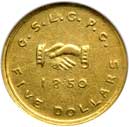 |
1850 Mormon $5 Gold. NGC graded AU-55. Light gold tone. Nice mint luster with lightly golden toning. Full struck with full fingers showing. A few minor obverse and reverse lines. Well struck and a fully AU55 coin. One of the better quality survivors from the 1850-dated issue we have handled.
The Mormon gold coins, struck on the orders of Brigham Young, were often of superior quality despite the poor equipment on hand to produce them. The same cannot be said for their purity, which caused some consternation in California and was one of the chief complaints leading to the Federal government establishing a Mint at San Francisco, California in 1854. The Mormon fives were all struck in 1849 and 1850 using a uniform system of determining weight and fineness; none were issued with the 1851 date. Due to the softness of pure gold a small percentage of silver was added to create an alloy, and thus, were more durable in circulation. A later issue in 1860 (the "Beehive" coins) is also noted.
The Mormon gold coins were struck mainly so the people within the settlement would have a sound means of payment to trade for goods produced back East, in the industrial part of the country. However, some were also used in a few non-Mormon businesses located in Utah. Because most of the coins were shipped East, there were virtually none left in circulation in the Mormon local market, according to historical accounts. Pop 5; 13 finer (PCGS # 10265) .
Estimated Value $25,000 - 30,000.
The Stocker Estate.
View details and enlarged photos
Check results on similar lots
| Realized
$36,800 |
Lot 2253 |
 |
1860 Mormon $5 Gold NGC graded AU Details. Reverse damage. Nice golden toning. The popular beehive on the reverse. Mostly vivid gold to green-gold hues, the surfaces are lightly abraded. Both sides are uncommonly sharp in strike with really no ill-defined features. There are scattered abrasions here and there, most of which are small in size and not singularly conspicuous, plus the aforementioned reverse damage at 12 o�clock affecting some of the lettering and rim dentils. Of course, a few moderate distractions are to be expected, particularly in the field. All-in-all, however, this is a pleasing Utah Territorial gold coin for the grade level.
The final issue from the Deseret Assay Office, the 1860 Five Dollar was struck between February 28, 1861 and March 9, 1861 from 1860-dated dies. The gold for this issue came from Colorado mines. Like earlier Mormon gold issues, the 1860 Five was popular in and around the Salt Lake Valley, but it proved a failure in circulation among the "Gentiles." Most examples that left Mormon territory were likely melted with the result that this is issue is seldom offered in any grade in even the largest auctions. Mint State coins are especially rare (PCGS # 10268) .
Estimated Value $10,000 - 12,000.
View details and enlarged photos
Check results on similar lots
| Realized
$17,825 |
Lot 2254 |
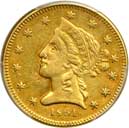 |
1861 Clark, Gruber & Co. (Denver, Colorado) $5 Gold PCGS graded Genuine AU Details. Surface tooled. We like this coin and believe that it is okay. Lovely toning. Struck in what was known as the Jefferson Territory (Colorado) in very limited quantities. Experts quote the mintage at about 6,920, but as with other Pioneer gold coins, many saw extensive circulation and many were melted to be struck into federal gold coinage. On April 16, 1863 the federal government purchased the Clark-Gruber & Co. firm with all of its equipment which eventually became the Denver mint (PCGS # 10140) .
Estimated Value $4,000 - 4,500.
View details and enlarged photos
Check results on similar lots
| Realized
$3,450 |
|
|